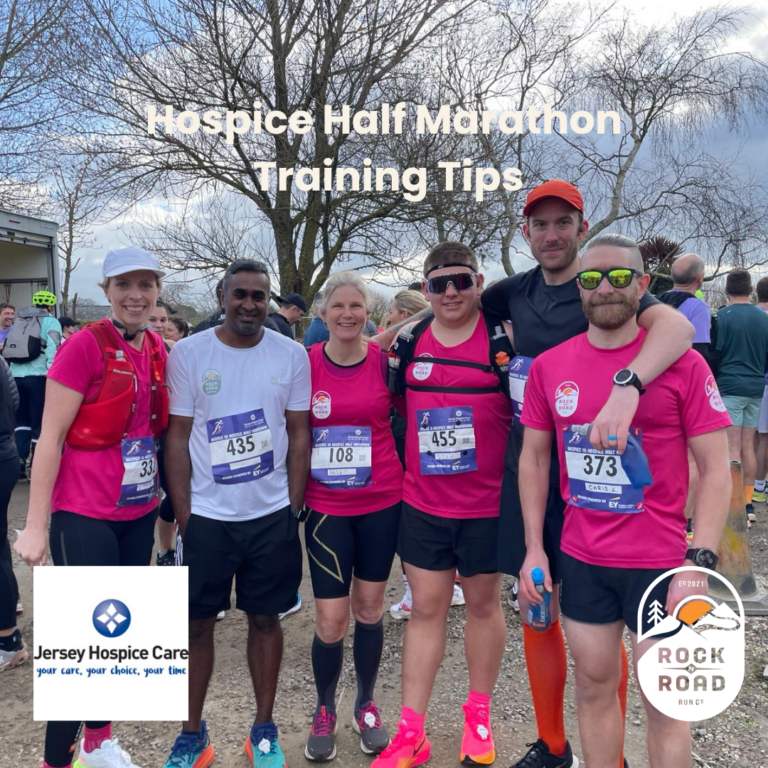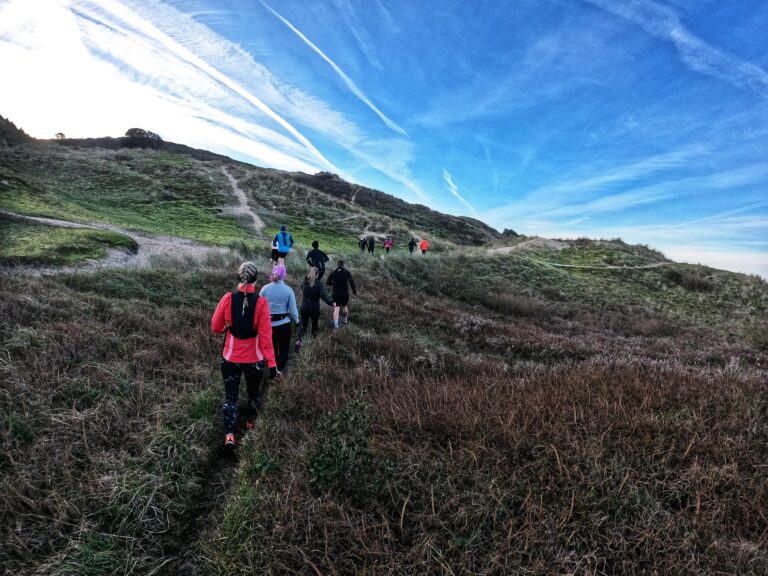
Hospice Half Marathon Training Tips
So we’re just 7 weeks out from the biggest half marathon on island! Although I’m sure that most of you know exactly what you’re doing and training is going just
So after a big race, I always advise my athletes to take at least a couple of weeks either completely off or to just engage in some light unstructured training. It’s really important to have both a physical and mental break and let the body and mind recover from the race and preceding training block.
Sometimes though, an athlete, against the advice and pleadings of their coach, will insist on booking in another big race soon after their last and we have to throw coaching logic out the window.
This time, I am this athlete.
I basically ran out of days in the year to race a UTMB qualifier to enter the lottery for 2024 in Jan so ended up registering for the Elephant 100k at Doi Inthanon by UTMB in Thailand on 9th December. This is also a world major so double stones for the lottery and I do love a bargain. It does mean that after subtracting the taper and a week’s recovery post-Amsterdam (which was mid-Oct), I effectively only had 5 weeks of solid training to get ready for the race.
A couple of caveats. Although I wouldn’t advise most people to pivot so quickly from a marathon to an ultra or to squeeze such a high volume of training into a short timeframe, the theory of how to breakdown and train for such an event stands. Additionally, I am used to high volume training and have been running fairly high mileage, consistently, without too much breakdown or illness, for a number of years.
The event takes places in Chang Mai, Thailand in the stunning mountains of the Doi Suthep-Pui National Park. The rub is that I’ve spent the last 12 months running mostly on roads, training for races lasting up to 3 hours (excluding Round the Rock) and I now have only 7 weeks to prepare for an event which will take place on technical trails with over 20,000 feet of elevation which will last upwards of 15 hours.
This is the context in which I breakdown the race and the reason why I meticulously planned the next 7 weeks of training. Every day of the next 42 days carries a great deal more weight than if I had a full 24-week training cycle – which is what I should be doing.
| THE ELEPHANT 100K | ||||
| Location | Doi Suthep-Pui National park, Chiang Mai | |||
| Distance | 96.5km | 60 miles | ||
| Elevation Gain | 6190m | 20,427ft | ||
| Elevation Gain by Distance | 64m per km | 340ft per mile | ||
| Elevation Loss | 6,029m | 19,780ft | ||
| Elevation Loss by Distance | 63m per km | 335ft per mile | ||
| Elevation Change | 12,219m | 40,207ft | ||
| Elevation Change by Distance | 127m per km | 670ft per mile | ||
| Terrain | 74% trail | 16% dirt road | 10% paved road | |
| Terrain Technicality | Very technical, steeps climbs/descents, off-trail sections & some trails not cleared yet | |||
| Race Start | 5am | |||
| Sunrise | 6:46am | Dawn | 6:22am | |
| Sunset | 5.48pm | |||
| Length of Daylight | 11hrs49 | |||
| Weather | Cool, dry | Max 28.6 /Min 15.7 | Heat Index 32 | Humidity 73% |
| Aid Stations | 8 | |||

The course profile is also really useful to give you an idea of how the race will play out and what to expect
What I haven’t included is a list of mandatory race kit, because this would be very boring. But make sure you know what gear is required so you can purchase it ahead of time, train with it, become proficient with using it and learn how it feels to run with. And yes, mandatory kit is mandatory. It’s not there for lol’s, it exists for your safety and protection so please don’t try and get by without it.
The first step is goal setting. If the race distance is new or the difficulty of the race is novel, then finishing the race should be your main goal. If you’re completed the distance before or have multiple gnarly ultras under your belt, you can start thinking about A/B/C goals as they relate to time and finishing position. Pick a goal which is challenging but achievable and select a number of A/B/C goals in case your main one dissolves as the race progresses and you need another to fall back on. The loftier your goal is, the more specific and challenging your training will be so think about how much time you have available, both in terms of day to day and week to week but also how much time you have until race day. This will determine how your training plan will be formulated and what adaptations you can focus on. Obviously training history and race experience factor in but Jason Koop suggests building up to, for 50k-50miles, 6 hours per week for 3 weeks, 6 weeks prior to race day & for 100k-100miles, 9 hours per week for 6 weeks, 9 weeks prior to race day. The final 3 weeks here are basically the pre-race taper where most of the work should be done. The longer your base building phase can be, the more training volume and intensity you will be able to handle. Remember, there are no shortcuts in training for ultra (and sub-ultra) distances!
For myself, this race is being used as a qualifier for the UTMB main event lottery so finishing is obviously the main aim. However, I would also like to be competitive, and having raced a number of similar races by distance/profile, I feel that a reasonable stretch goal would be sub-15 hours. Looking at the top 20-30 finishers from previous years and stalking their Strava Profiles, I feel that I could mix it up these guys. Obviously a lot would have to go right for this to happen but we all have to dream right?
The next step involves breaking down the course and finding out as much information about the race as possible. Without knowing these details, you can’t plan your training to meet the demands of the day and it also leaves a lot of room for surprises on race day. We don’t like surprises in ultras.
A lot of info will be available on the event website but to fill in the gaps you can read race reports, watch YouTube videos or join Strava and Facebook groups set up by the event or by local running groups. I joined the ‘Chang-Mai Trail Running Tribe’ FB group and found out that the terrain would be much more technical and way steeper than last year with lots of the trail still needing cutting back and made runnable. Armed with this info I could plan my training to handle these conditions.
Calculating total elevation change or total ascent per km/mile is especially important as you’ll want to be matching this figure in your training per week and during long runs as the race approaches. So for this race, I will be aiming to build up towards 20,000ft of elevation gain per week with long runs matching the elevation change per mile. Most of this will be completed outdoors so the descent will be similar and should take care of itself. For hilly or mountainous ultras, preparing adequately for the climbing and descending is much more important than total mileage and both are tackled in different ways which I will go into more detail later. Other details such as the distance between aid stations, terrain type, daylight hours and weather are all important too. You can develop downhill trail running skills, build confidence running at night and you can train for the heat even in UK winter to help prepare you for these factors.
Once you’ve sketched the outline of the race, you’ll want to start shading in. Breakdown the course into discreet sections, which is usually done by aid stations/checkpoints.
| Aid Stations Breakdown | Section | Distance | Total Distance | Elevation Gain | Elevation Loss | Cut Off | Aid |
| B1a: Helipad | 11.5km | 11.5km | 1048m | 97m | Drinks | ||
| B2: Srinehru School | 12.2km | 23.7km | 798m | 742m | Sat 1pm (8hrs) | Hot Food | |
| B3: Huay Tueng Thao Reservoir | 7.5km | 31.2km | 91m | 1086m | Food & drink | ||
| B4: Mae Sa Elephant Camp | 9.4km | 40.7km | 452m | 268m | Sat 5pm (12hrs) | Food & drink | |
| B5: Chao Pho Luang Upatham 7 School | 9.4km | 50.2km | 954m | 476m | Hot Food | ||
| B6: Khun Chang Khian Highland Research Station | 12.9km | 63.1km | 929m | 789m | Food & drink | ||
| B2: Srinehru School | 6.5km | 69.6km | 666m | 468m | Hot Food | ||
| B7: Pha Dam Forest Ranger Unit | 12.6km | 82.2km | 889m | 830m | Sun 2.30pm (21.5hrs) | Food & drink | |
| Royal Park Rajapruek | 12.7km | 95km | 204m | 1273m | Sun 6pm (25hrs) | Hot Food |
| Main Climbs | Main descents | Grade Ascent | Grade Descent |
| 1048m/3458ft | 9.10% | ||
| 6.54% | |||
| 1086m/3583ft | -14.56% | ||
| 4.80% | |||
| 954m/3148ft | 10.15% | ||
| 7.20% | |||
| 10.25% | |||
| 7.06% | |||
| 1273m/4200ft | -10% |
Armed with this info, I can start to plan my training so I can be as prepared as possible for the savagery of the Chang-Mai mountain jungle.
When planning your training, you need to think about what training adaptations you’re trying to elicit. With sub-ultra distance road races, you’re basically trying to improve Vo2max, Lactate Threshold and Running Economy. With ultramarathons, especially trail races, there are many many factors which influence performance outside of these 3 variables. Exercise physiologist, Guillaume Millet, outlines some of these below:

What this basically means, is that we need to train and prepare for lots of different factors outside of just speed and endurance. You need to figure out both what your strengths & weaknesses are and what the specific demands of your chosen race will be. There isn’t much benefit in running a lot of 5k paced work on flat roads when your race will be taking place in the mountains over multiple days for example.
The unique demands of The Elephant 100 are the long, steep climbs and descents (local runners suggested some climbs are 18% – the Les Platons steps are 16.7% by comparison), the potential for hot and humid conditions and the technicality of the trails.
For me specifically, I needed to focus on the following over the 7 weeks prior to race day:
Whilst uphill running/climbing performance is limited largely by cardiovascular fitness, running downhills is limited by eccentric muscle damage. Basically your muscles develop so much damage they become useless, painful meat sticks. Most people focus on the climbing portion of a race but your day can often be derailed by blowing out your Quads on long, punishing downhills. Some races are long enough where you develope DOMS (Delayed-Onset Muscle Soreness) during the actual event. It’s a silly sport.
I’ve been running flat roads for 12 months so my descending skills have been gone down the toilet. The less proficient and confident you are descending, the more load you’ll put through your body (which isn’t good – see above) and the slower you’ll be overall.
This sport can sometimes be a misnomer. Ultra-hiking might be more appropriate. Races of 50k+ on hills/mountains will probably require you to walk (sorry, POWER HIKE) up the climbs. This is not only OK, but smart. If you develop a strong and efficient hiking technique, you’ll most likely overtake a lot of people running on the spot uphill and save a tonne of energy in the process. Which is good.
I generally respond well in the heat but even a cold day in Chang-Mai will be a shock coming from Jersey Winter. If you’re not prepared for the heat (or the cold), then everything on race day will be harder. For example, your ability to thermoregulate, to maintain a higher output, to consume calories, etc. Luckily these conditions can be trained for.
Races with a lot of vert and descent can often be made more tolerable by using running poles but to use these effectively they require A LOT of practice, especially on the descents. I’m pretty rusty and I don’t imagine I’ll have time to improve much, especially in Jersey, so I might fail this one miserably.
This has been my intake regularly throughout the year for time durations up to 7 hours. Being able to maintain this for 15 hours will be more challenging so I will need to not only continue to practice proper fuelling in training (for performance and recovery) but to experiment with other forms of carbohydrate intake should my decision to try and consume 30 x 40g gels not pan out.
So this is how I broke down the race and gleaned the info I needed to plan my training. My next article will outline my training plan and you’ll find out whether I managed to execute it. Hope this has been helpful!

So we’re just 7 weeks out from the biggest half marathon on island! Although I’m sure that most of you know exactly what you’re doing and training is going just


With all the different types of shoes on the market how do you separate the marketing from the facts and decide which is best for you? The first thing to

This morning we had our third ‘Intro to Trail Running’ session in and around the Sand Dunes. Attendance has grown each time, which is awesome to see, but I am
© Rock N Road 2025 - All Rights Reserved